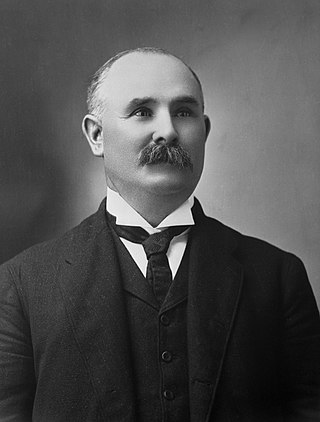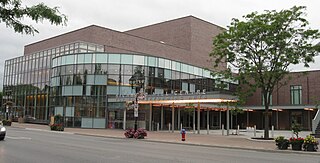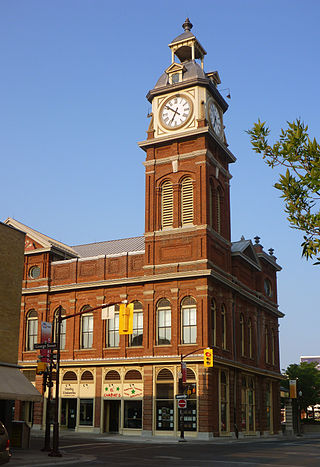
The Bank of America Corporate Center is an 871 ft (265 m) skyscraper in Uptown Charlotte, North Carolina. Designed by Argentine architect César Pelli and HKS Architects, and best known as the headquarters of the namesake Bank of America, it has been the tallest building in North Carolina since its 1992 construction, and is the 31st-tallest building in the United States as well as the 174th-tallest building in the world.
The Southern Alberta Institute of Technology (SAIT) is a polytechnic institute in Calgary, Alberta, Canada. SAIT offers more than 110 career programs in technology, trades and business. Established in 1916, it is Calgary's second oldest post-secondary institution and Canada's first publicly funded technical institute.

Arts Commons is a multi-venue arts centre in downtown Calgary, Alberta, Canada, located in the Olympic Plaza Cultural District.

The Queen Victoria Market is a major landmark in the central business district (CBD) of Melbourne, Victoria, Australia. Covering over seven hectares, it is the largest open air market in the Southern Hemisphere.

The Queen Victoria Building is a heritage-listed late-nineteenth-century building located at 429–481 George Street in the Sydney central business district, in the state of New South Wales, Australia. Designed by the architect George McRae, the Romanesque Revival building was constructed between 1893 and 1898 and is 30 metres (98 ft) wide by 190 metres (620 ft) long. The domes were built by Ritchie Brothers, a steel and metal company that also built trains, trams and farm equipment. The building fills a city block bounded by George, Market, York, and Druitt Streets. Designed as a marketplace, it was used for a variety of other purposes, underwent remodelling, and suffered decay until its restoration and return to its original use in the late twentieth century. The property is owned by the City of Sydney and was added to the New South Wales State Heritage Register on 5 March 2010.

Downtown Calgary is a dense urban district in central Calgary, Alberta. It contains the second largest concentration of head offices in Canada, despite only being the country's fourth largest city in terms of population. The downtown is divided into several residential, commercial, corporate, and mixed-use neighbourhoods, including the Financial District (CBD), Eau Claire, Chinatown, East Village, Beltline, and the West End.
The Cultural District is a fourteen-square block area in Downtown Pittsburgh, USA bordered by the Allegheny River on the north, Tenth Street on the east, Stanwix Street on the west, and Liberty Avenue on the south.

Patrick Burns was a Canadian rancher, meat packer, businessperson, senator, and philanthropist. A self-made man of wealth, he built one of the world's largest integrated meat-packing empires, P. Burns & Co., becoming one of the wealthiest Canadians of his time. He is honoured as one of the Big Four western cattle kings who started the Calgary Stampede in Alberta in 1912.
The Shops at North Bridge, once known as Westfield North Bridge, is an upscale, urban retail-entertainment district in Chicago, Illinois, located at 520 N. Michigan Avenue. Its anchor store is Nordstrom. Its name alludes first to its location within the nine-block North Bridge complex and to the literal distinction of the shopping center incorporating four-level enclosed bridges over both east Grand Ave, and north Rush Street. When Westfield owned the mall, confusingly, "Westfield North Bridge" typically refers only to the enclosed mall, but Westfield holds a retail management contract for the entire North Bridge complex, which includes another multistory retail complex built in 1995 and street-level retail spaces throughout the complex. North Bridge also includes five hotels, three parking garages, and two office buildings, housing the American Medical Association and Euro RSCG. Upon opening, it also included a DisneyQuest "urban amusement park," since converted into a furniture store.

The Hammond Building was a high-rise building completed in 1889 at the southeast corner of Griswold Street and West Fort Street in the financial district of downtown Detroit, Michigan directly across Fort Street from the Detroit City Hall. The 46 m (151 ft) building was designed by George H. Edbrooke, and is considered the first skyscraper in the city, and was the tallest in the state when built. Russell Wheel & Foundry supplied and erected the iron and structural steel for the building. The Hammond Building was demolished in 1956 to make way for the National Bank of Detroit Building, which has since been renamed The Qube. At 12 stories, the steel-framed United Way Community Services Building (1895), originally the Chamber of Commerce Building, qualifies as Detroit's oldest existing skyscraper.

Midtown Plaza is a city district that is redeveloped for various uses. It used to be an indoor shopping mall in downtown Rochester, New York, the first urban indoor mall in the United States.

The Bow is a 158,000-square-metre (1,700,000 sq ft) skyscraper in downtown Calgary, Alberta, Canada. The 236 metre (774 ft) building is currently the second tallest office tower in Calgary, since construction of Cenovus' Brookfield Place; and the third tallest in Canada outside Toronto. The Bow is also considered the start of redevelopment in Calgary's Downtown East Village. It was completed in 2012 and was ranked among the top 10 architectural projects in the world of that year according to Azure magazine. It was built for oil and gas company Encana, and was the headquarters of its successors Ovintiv and Cenovus.

Regent Theatre was a heritage-listed cinema at 167 Queen Street, Brisbane, Australia. It was designed by Richard Gailey, Charles N Hollinshed and Aaron Bolot and built from 1928 to 1929 by J & E L Rees and A J Dickenson. It was one of the original Hoyts' Picture Palaces from the 1920s. It is also known as Regent Building. The auditorium interior was largely lost when it was converted into a 4 screen complex in 1979–1980, but the building, including the surviving entrance and main foyer, was added to the Queensland Heritage Register on 21 October 1992.

The Richmond Hill Centre for the Performing Arts is a 43,000-square-foot (4,000 m2) multi-use cultural facility on 1.5 acres (6,100 m2) of land directly on Yonge Street in Richmond Hill's downtown core, at the corner of Yonge and Wright Streets.

The Grand, stylized as The GRAND, is the oldest theatre in the downtown core of Calgary, Alberta, Canada. In its current incarnation, it houses and operates the 436-seat Flanagan Theatre and a rehearsal space, the Studio.

The Bellingham National Bank Building is an historic commercial/office building located in downtown Bellingham, Washington. It was originally built from 1912 to 1913 in a restrained Beaux Arts commercial style with reinforced concrete. Even though this particular style was common for cities in the midwest and east coast, the building style was a stark contrast for Bellingham's sandstone and rounded arch buildings. The Bellingham National Bank occupied the building starting on December 1, 1913.

The Strathcona Public Building, Old Strathcona Post Office, South Side Post Office or South Edmonton Post Office is restored heritage building in Strathcona Square in the Old Strathcona heritage district of Edmonton. The restored building along with a Festival Market was opened to the public on the first weekend of September 1988 and the place came to be known as Strathcona Square.

Downtown East Village more commonly known as simply East Village, is a mixed-use neighbourhood within the eastern portions of downtown Calgary, Alberta, Canada. It is contained within the city's Rivers District. Containing the earliest-settled land in the Calgary area - Fort Calgary - East Village was for years a mixture of high-rise residential, commercial, and industrial development. Much of the parkland currently surrounding Fort Calgary was industrial as recently as the 1960s. Construction of the city's light rail transit Blue Line, coupled with the closure of 8th Avenue at Macleod Trail in the early 1980s by construction of the massive Calgary Municipal Building, resulted in East Village being "cut off," figuratively speaking, from the rest of downtown. As a result, it became home to many rundown properties and vacant lots over the years, and a severe crime problem.
The Barron Building is an eleven-storey office tower located at 610 8th Avenue Southwest in Calgary, Alberta, Canada. Designed by architect Jack Cawston and built between 1949 and 1951, it is one of Canada's foremost examples of Art Moderne-style architecture. In 2003 it was named by the Alberta Association of Architects as Significant Alberta Architecture.

Market Hall is a commercial building and performing arts centre in the downtown core of Peterborough, Ontario, Canada. Originally built as the city's market hall, it has housed a variety of tenants since and has been home to the Market Hall Performing Arts Centre since 1998.

















